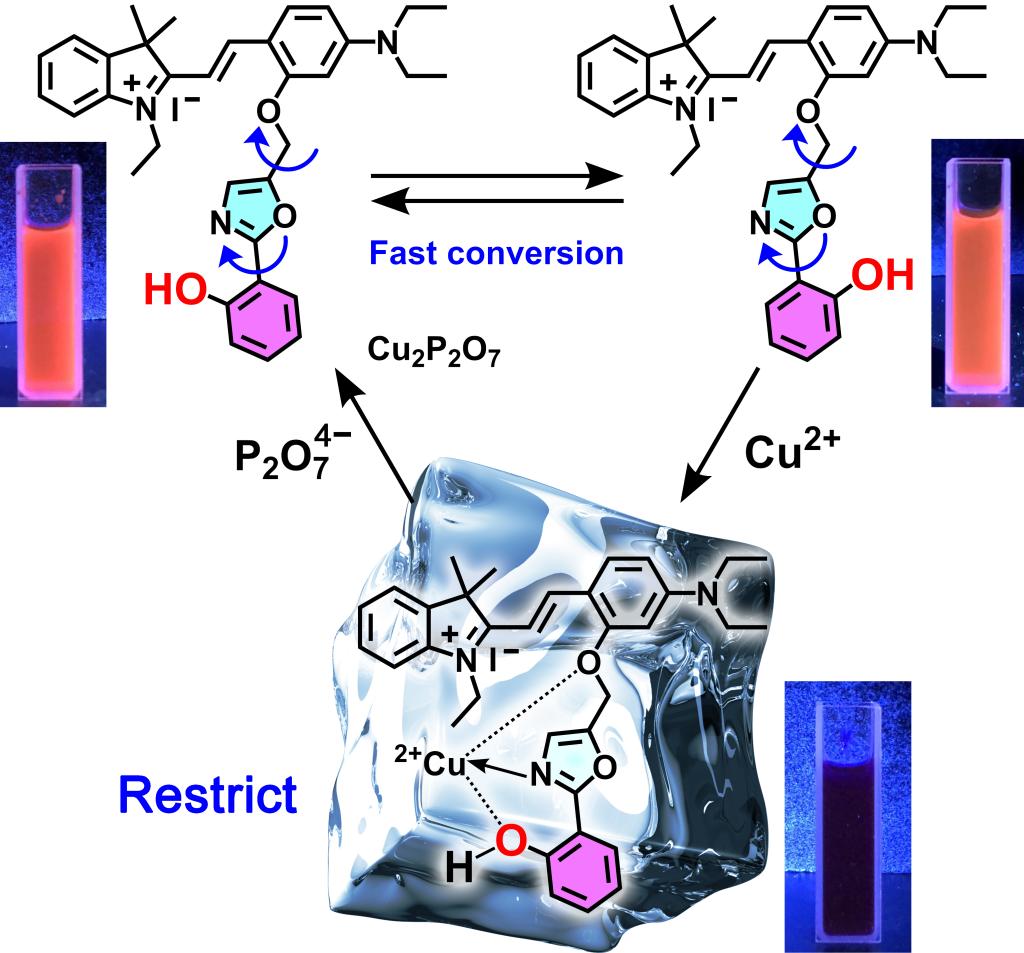近日,我组(生物分离与界面分子机制研究组,18T7组),设计并合成了一种新型的近红外荧光探针,该探针通过与铜离子特异性的结合,以及焦磷酸阴离子调控的铜离子解离,实现了对2-(2'羟基苯基)-4-甲基噁唑(HPMO)分子构型转换可逆的冻结。
近红外荧光探针由于具有背景干扰小、组织穿透性好、对细胞光毒性低、摩尔吸收系数高等显著优势,在分子识别、金属离子检测、生物分子相互作用、细胞成像等领域得到了广泛应用。然而,近红外荧光探针在研究分子构型方面的应用却鲜有报道。同时,分子构型的研究在合成化学、医学、生物化学等领域都发挥着不可或缺的作用。因此,开发一种高效、简便的方法来调控分子构型,特别是候选药物的构型,将微小的构型差异转化为易于识别、鉴定和测量的分子宏观性质的变化,具有非常重要的意义。
我组报道了一种高度特异、可逆和可见的方法来调控HPMO(一种用于构型研究的经典模型系统)分子的构型,与Cu2+的特异性结合成功地减缓了苯酚和噁唑在C–C单键上的自由旋转,最终锁定了HPMO的构型。这一过程反映为探针分子的宏观性质,如荧光颜色由亮红色变为暗色,并且具有明显的自组装行为。限制分子构型的转变有利于确定分子的绝对构型,研究其荧光机理,发现有机分子的独特性质。重要的是,本研究揭示了近红外荧光探针在监测分子构型转变方面的巨大潜力,将分子光谱学的研究扩展到分子动力学的分析,为理解构型转变过程提供了更深入、真实的视角。与其他方法相比,基于荧光的方法具有响应速度快、分辨率高、光谱和颜色变化显著、测量方便、不需要昂贵设备等独特优势。受此启发,深入研究可能会发展出一种新的技术,可用于分子构型的测量。另外,Cu2+与P2O74-之间的竞争性结合可以使“冻结”的分子结构解冻,而其他阴离子则不具备这种能力。这使得该方法具有很高的特异性、可控性和可逆性。基于两种结构之间的可逆开关,智能分子开关器件在生物传感、生物芯片和微流体器件等领域有着广泛的应用前景。
相关成果发表在《美国化学会》期刊ACS Sensors 上 (2020, DOI: 10.1021/acssensors. 0c00619)上,第一作者是18T7组硕士研究生常永新。以上研究工作得到国家自然科学基金项目、我所创新特区组启动基金、兴辽英才计划等项目的支持。
Visible and Reversible Restrict of Molecular Configuration by Copper Ion and Pyrophosphate
Yongxin Chang, Haijuan Qin, Xue Wang, Xiaopei Li, Minmin Li, Hang Yang, Kuoxi Xu,* and Guangyan Qing*
ACS Sensors, 2020
DOI: 10.1021/acssensors. 0c00619

Molecular configuration strongly impacts on its functions, however, due to complicated and diverse configuration as well as easy and rapid conversion among various configurations, research of molecular configuration is extremely difficult. If the free rotation of a molecule could be “slowed down” or even “frozen” by an external stimulus, such as ultra-low temperature, one configuration of the molecule could be captured and characterized relatively easily. Here we show that the rotation of a hemicyanine‒labelled 2-(2’-hydroxyphenyl)-4-methyloxazole (H-HPMO) molecule could be specifically and reversibly restricted by sequential additions of copper ion (Cu2+) and pyrophosphate (P2O74–), reflecting as remarkable fluorescence quenching and recovery, which could be directly observed by naked eyes. Binding affinity tests and cryogenic 1H NMR indicate that Cu2+ forms intensive coordinate bonds with phenolic hydroxyl, oxazole, and methoxyl groups of HPMO, which strongly restricts the free rotations of these groups and blocks charge transfer. This study provides a precise, rapid, visible, reversible and low-cost method to monitor the molecular configuration, indicating the broad application prospects of near-infrared fluorescent sensors in configuration analysis, biosensing, drug–substrate complexation.